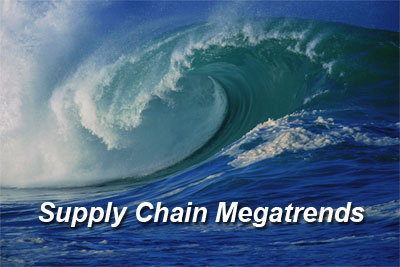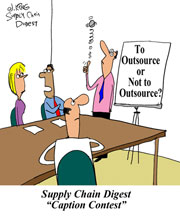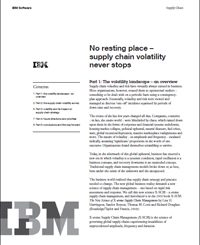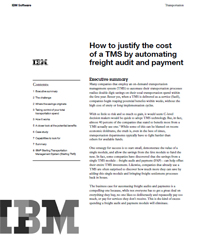 |
March 15, 2012 - Supply Chain Newsletter |
 |
This Week In SCDigest
FEATURED SPONSOR: Seagull Scientific |
To precisely and individually control who can |

Supply Chain Megatrends 2012 To be honest, I didn't fully carry them quite through as well as I had hoped, with plans to do executive summaries of each trend and some other related activities. I only made it about half way through. •Supply Chain Alignment •Actionable Visibility •Virtualization •Performance Management •Lean Supply Chains
So with any further ado, here is the first half of our Supply Chain Megatrends list for 2012, of which there will be 12 in total:
1. Turbo Supply Chain Visibility: A combination of technologies - from RFID to GPS to video - is making the level of the level of visibility we can have in our supply chains right now almost limitless There is almost no technical barrier today to complete visibility - seeing everything, all the time, in real time, or darn close to it. Over the next five years, what this will mean is that company's need to decide at what pace they are going to roll out these turbo visibility capabilities - and more importantly, better think through what to do with this level of information. Few of us well understand this today. It will transform our supply chains. 2. Perfect Logistics: This level of visibility will mean that for all practical purposes, companies will be able to achieve near perfect logistics. We are already seeing components of it today, with route deliveries being tracked in real-time, analytics off of that which identify any time a driver appears like he or she will miss the schedule appointment time even by a few minutes, re-routing drivers as conditions change, and more. Missing cartons on pallet? Soon, an absolute thing of the past. This level of near perfection will simply be what customers expect. The question will be how much it costs to get there. In a sort of odd way, it will also serve to in a sense further commoditize logistics. 3. Blurring of Planning and Execution: Visibility plus need for more rapid response to supply chain and market place dynamics will alter how companies look at the traditional supply chain hierarchy from strategic planning through tactical and operational planning and then on down through execution. While elements of this top down, sequential model that has been with us from the start will remain, near the end, operational planning and execution will start to become almost a single process, and even tactical planning will become more dynamic. Clearly, planning cannot be dependent on 30-day S&OP schedules. This will impact not only how we operate our supply chains, but have ramifications for supply chain technology and most interestingly, how our supply chains are organized.
4. International to Global: Despite the tremendous growth in globalization on both the supply and demand side in the past decade, many if not most companies are really national companies that do business (buy and sell) on an international basis. That model is rapidly evolving to full globalization, where companies are truly trans-national in their strategies, organization and leadership. Many companies, such as Siemens, IBM and Procter & Gamble, have already largely arrived here already (IBM's head of procurement had been in Asia for a number of years, just as an example), and to succeed in the rapidly growing emerging markets will take innovative and tailored approaches to product, planning, and logistics that require a true global perspective. 5. Talent Management: Companies want to maintain lean staffs (that's an understatement), but want to outthink and outperform their competition through supply chain at the same time. In the end, that will mean the need for fewer, smarter people. Growing supply chain complexity while overall Lean practices are still the rule results in a sort of supply chain high wire act that again drives the need for talent (though clearly technology will also play a key role here). The need for better integration with the business also challenges traditional, "move the goods" types of expertise. All this just means the demand for talent will in general exceed the supply for the next decade, driving more companies to develop programs that identify, develop and retain the talent they have. We've had a few leaders here for years - The Limited Brands, Frito-Lay (PepsiCo), P&G - but many companies will start to take talent management a lot more seriously, while others make little effort and just hope to pick off talent from the leaders. 6. Supply Chain Finance: The connection between supply chain and a company's financial performance has been at once both well known but not so well understood. There was something of a watershed with the 2008-09 financial crisis, when companies in effect used the supply chain as a source of cash as traditional credit simply dried up. The next five years will see the field of supply chain finance continue to mature, and understanding how supply chain impacts the income statement, balance sheet, cash flow statement, and return on assets will become almost essential to reach upper level positions in supply chain. This will be an increasingly common area of internal supply chain training (as some do today). The position of VP of Supply Chain Finance, found in a few companies already, will become more common. Ok, there are the first six Supply Chain Megatrends for 2012. The remaining set in two weeks, and will again cover each in more detail during the rest of the year. Hope you enjoy them.
|
|
||||||||||||||||||||||||||||||||||||||||||||
Tuesday's Videocast:
The Real Deal in WMS Selection
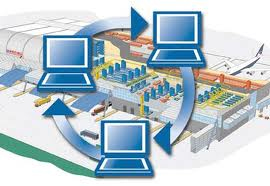
Seven Smart Moves to Enhance Your Success in Getting the System and Results that are Right for You
Featuring John Pearce, Founding Partner & Principal, StoneCross Group; Steve Hopper, Founding Partner & Principal, StoneCross Group; and Joel Stachowski, Strategic Sales Executive, Infor Global Solutions
On Demand Videocast:
Operations Rules for Driving
Business Value & Growth
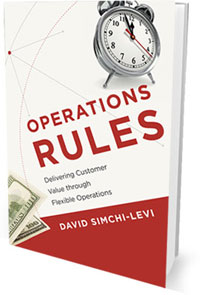
Part 1: Mitigating Business Risks from the Known-Unknown to the Unknown-Unknown
Featuring Prof. David Simchi-Levi, Professor of Engineering Systems, MIT
who unveiled the Innovative New Supply Chain Risk Exposure Index
On Demand Videocast:
Managing Risk in a
Multi-Tier Supply Chain

Look Beyond Tier One Suppliers to Lower Risk, Optimize Costs, and Enhance Resiliency
Featuring Tom Linton, SVP and CPO at Flextronics; Thomas Choi, Professor of Supply Chain Management at Arizona State University, School of Business; and Rich Becks, General Manager, High Technology at E2open
We received a number of letters on our piece saying that use of natural gas engines for both cars but especially trucking could substantially reduce the cost and variability of oil, gas and diesel (See Higher Oil and Diesel Prices - the Answer is Here.) We published a few of them this week, including our Feedback of the Week from Dr. John Hansen of the Supply Chain Management Institute, who says there may be some issues with our theory. More next week. Feedback of the Week: On Natural Gas Engines:
|
||
I suppose it's always easy to raise niggling objections to great ideas, but the key issue I recall from my days working in automotive air, fuel and emissions was the significant lack of consistency of natural gas as a product. This meant basically that vehicles had to be calibrated for their local supply; not a big problem for local buses or the private fleets mentioned in the article, but problematic for interstate commerce. John D. Hanson, Ph.D.
|
||
More on Natural Gas Engines:
|
||
Nat Gas Pricing is low now and diesel very high - opposite ends of the spectrum. Edward Blickstein
|
||
There is no match between the resources and consumption of natural gas that US has with Pakistan but this seems to be a dangerous path. In Pakistan, have a good network of CNG (Compressed Natural Gas) stations here in Pakistan and about 60% of transportation shifted on to CNG only to know that the natural gas is not sufficient. Since the CNG was a lucrative business and cheaper than petrol / diesel there was huge growth but now what we hear is that CNG stations will be closed for three days a week because natural gas for industrial and residential use is not enough. CNG station owners are going through tough times as government has asked them to open only three days a week, vehicle owners are also suffering as they have to run on petrol/diesel 3 days due unavailability of CNG and if its available there is long queue and wait to get your car filled up. Using of natural gas in transportation must be planned out properly to avoid demand/supply problems in near future. Syed Bokhari
|
||
SUPPLY CHAIN TRIVIA ANSWER
Q: In what year did oil prices peak in inflation adjusted terms: 1973, 1979 or 2008, based on monthly average? Bonus question: Since 1985, the inflation adjusted low oil price occurred in what year, plus or minus one year?
A: While prices really spiked in 1979, up to $111 dollars in inflation adjusted terms (monthly average), that was still below the more than $130 per barrel seen in June, 2008. The low point was in sometime in 1999, at just about $15 per barrel.
| © SupplyChainDigest™ 2003-2012. All Rights Reserved. SupplyChainDigest PO Box 714 Springboro, Ohio 45066 |
POWERED BY: XDIMENSION |

